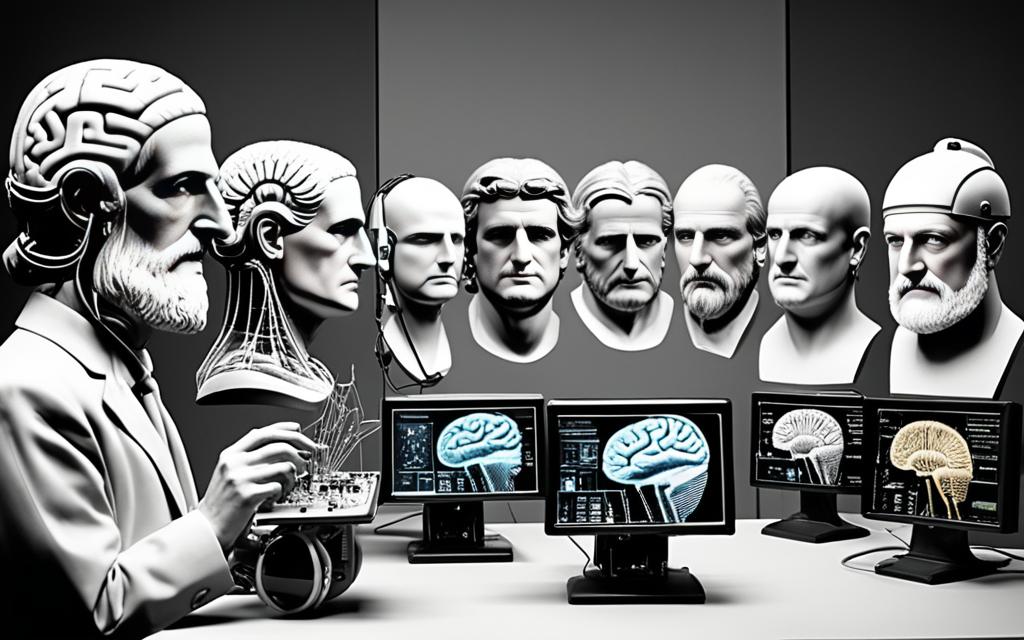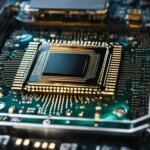Table of Contents
The journey of brain-computer interfaces (BCIs) is a fascinating tale of science and technology merging. It tells how human thought and computers can work together. This adventure starts with the early work on electroencephalography (EEG). It moves to breakthroughs in neuroprosthetics that have changed how we connect with machines. Historical landmarks include Hans Berger’s creation of the first EEG in 19241. José M. Delgado’s stimoceiver is another key innovation, showing the power of these technologies.
We will explore major advances, like implantable devices, and their impact since the 1970s. This story reaches up to the present, where BCIs have a wide range of uses.
Key Takeaways
- The foundations of BCIs can be traced back to early 20th-century electroencephalography advancements.
- José M. Delgado’s stimoceiver was a pioneering implantable solution, demonstrating profound implications for brain activity stimulation.
- The term “Brain-Computer Interface” was introduced by Jacques J. Vidal in 1973, paving the way for future research.
- Significant strides in neuroprosthetics have enabled surgeons to help patients regain functionalities lost due to injury or disease.
- Research has shown that BCIs can facilitate neurorehabilitation for individuals recovering from strokes.
The Early Foundations of Brain-Computer Interfaces
Hans Berger and Richard Caton started the journey toward brain-computer interfaces (BCIs). Their work laid the groundwork for BCI research. They introduced methods to record brain activity.
Hans Berger and the First Electroencephalography
In 1924, Hans Berger brought about a new way to study the brain using electroencephalography (EEG). This method recorded the brain’s electrical activity without surgery. At first, people doubted Berger’s findings. Yet, his work sparked great interest in EEG. He used silver foil electrodes to make clearer brain activity recordings.
The Influence of Richard Caton
Richard Caton made important discoveries in the late 19th century. He found electrical activity in animal brains. This showed the possibility of understanding brain functions through electric signals. His work, like Berger’s, was key to improving how brain activity is recorded. Their efforts led to major advances in neuroscience. They laid the groundwork for future BCI technologies.
“The studies conducted by Berger and Caton mark significant milestones in our understanding of brain dynamics.”
| Researcher | Year | Contribution |
|---|---|---|
| Hans Berger | 1924 | First to use EEG for brain activity recording. |
| Richard Caton | Late 1800s | First to document electrical potentials from animal brains. |
| Impact | N/A | Foundation for modern neuroscience and BCI technologies. |
Hans Berger and Richard Caton’s early work still impacts us, leading to today’s BCI technologies. They encouraged future researchers to explore further. This opened the door to the incredible uses of brain-computer interfaces2.
Initial Breakthroughs in Brain-Computer Interface Technology
Brain-Computer Interface (BCI) technology has come a long way, thanks to pioneers like José M. Delgado and Alvin Lucier. Their early work laid the foundations for today’s BCI applications and techniques. It marked key moments in how we understand our brain’s connection with machines.
José M. Delgado and the Stimoceiver
In the 1960s, José M. Delgado unveiled the stimoceiver, a device that could stimulate the brain directly. It created various sensations in animals and humans, leading to more research in direct brain manipulation. Despite some ethical concerns, Delgado’s work paved the way for future neuroscience breakthroughs.
Alvin Lucier and the Use of EEG Data
Alvin Lucier took an innovative step in 1965 by combining EEG data with analogue signal processing. He turned brain waves into music played on percussion instruments. This was one of the first examples of a brain-machine interface in real action. Lucier’s work not only made brain-computer connections more plausible but also opened up discussions on enhancing human abilities through technology.
His experiments showed how brain activity could control digital spaces and improve how we interact with3.
The Evolution of BCIs in the 1970s
The 1970s were a groundbreaking time for BCI technology, thanks to major advances. Jacques J. Vidal introduced the term “Brain-Computer Interface,” showing a new path for linking the brain to machines. This term introduction showed the goal of combining human thought with computers.
The Coining of the Term “Brain-Computer Interface” by Jacques J. Vidal
In 1973, Jacques J. Vidal proposed a big idea that changed how we think about brains and computers. His concept laid the foundation for BCIs. It helped craft the vision of creating devices that could understand brain signals and respond to them.
Significant Animal Studies by Eberhard Fetz
Eberhard Fetz’s work with animals opened new doors for BCI research. His team taught monkeys to control brain cells, leading to advances in human BCI trials4. This work was vital for later breakthroughs in helping people through technology.
They discovered that tiny electrodes could pick up detailed brain signals4. Also, certain brain wave patterns were linked with these signals4. These findings helped us better understand how our brains work.
These early steps were crucial in developing BCI technology. They spurred growth in neuroscience and biomedical engineering. Today, animal research remains key to new discoveries in this area.
History of brain computer interface: Major Milestones in the 1980s and 1990s
In the 1980s and 1990s, brain-computer interface (BCI) technology saw huge changes. It focused on helping people with disabilities live better. Innovative work led to new uses, aimed at giving back freedom to those with mobility issues.
The P300 speller came out during this time. It was a big step forward. This system allows users to choose letters on a screen to spell out words. It uses signals from the brain, first talked about by Farwell and Donchin in 1988. This was a key moment. It showed BCIs could help people with disabilities communicate and be more independent5.
Pioneering BCI Applications for the Disabled
This period was marked by a push for BCI applications to aid the disabled. Around the globe, research pushed forward. Many studies showed how BCIs could help restore abilities lost.
Important projects led to the control of devices with the brain. This could bring back the feeling of touch after paralysis. Such work highlighted how BCIs could have a real impact in people’s lives6.
The Development of the P300 Speller
The P300 speller was crucial in advancing BCI tech. It linked brain science to helpful technology. It could read brain signals and let users communicate. This was a huge advance.
Success stories showed that, with more work, BCIs could change lives. They laid the groundwork for a better understanding of brain communication. There’s ongoing work to make BCIs more reliable and longer-lasting for users. This reflects the lasting influence of BCI breakthroughs in the 1980s and 1990s5.Explore more about the evolution and impact of BCIs
FAQ
What are brain-computer interfaces (BCIs)?
BCIs let our brains talk directly to machines. This amazing tech turns thoughts into action on devices without moving a muscle.
Who pioneered the study of brain activity through electroencephalography?
Hans Berger made a leap in 1924. He was the first to use EEG to see how our brains work, starting a new science era.
How did José M. Delgado contribute to BCI technology?
José M. Delgado made a big mark with his stimoceiver. This brain chip could change how neurons talk, pushing BCIs to new heights. Yet, it raised big questions about messing with our minds.
The 70s were huge for BCIs. Jacques J. Vidal named them in 1973. Then, Eberhard Fetz showed brains and computers could chat both ways.
What was the relevance of the P300 speller developed in the 1980s?
In the 80s, the P300 speller was a game-changer. It opened a new world for those with disabilities, letting them spell on screens by thinking.
How did early BCI research inspire modern neuroprosthetics?
Early BCI breakthroughs paved the way for today’s tech, especially in helping people with disabilities. They showed how close our minds can get to machines.
Source Links
- https://thebrainybits.com/the-history-of-brain-computer-interface-technology/ – The History Of Brain-Computer Interface Technology – When, Where, And How It Started? – The Brainy Bits
- https://www.simonsfoundation.org/2023/03/28/a-scientists-quest-for-better-brain-computer-interfaces-opens-a-window-on-neural-dynamics/ – A Scientist’s Quest for Better Brain-Computer Interfaces Opens a Window on Neural Dynamics
- https://en.wikipedia.org/wiki/Brain–computer_interface – Brain–computer interface
- https://www.sciencedirect.com/science/article/abs/pii/S0959438810001789 – Evolution of brain–computer interface: action potentials, local field potentials and electrocorticograms
- https://www.wired.com/story/this-man-set-the-record-for-wearing-a-brain-computer-interface/ – This Man Set the Record for Wearing a Brain-Computer Interface
- https://bioelecmed.biomedcentral.com/articles/10.1186/s42234-021-00076-6 – Historical perspectives, challenges, and future directions of implantable brain-computer interfaces for sensorimotor applications – Bioelectronic Medicine








